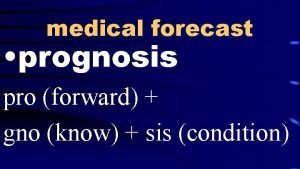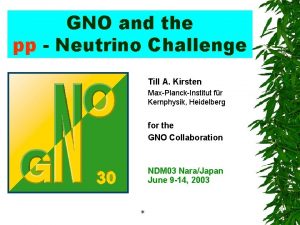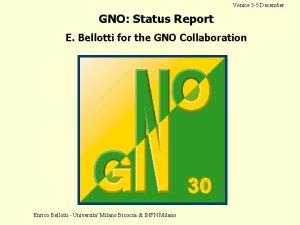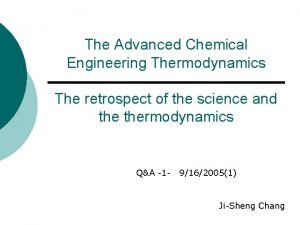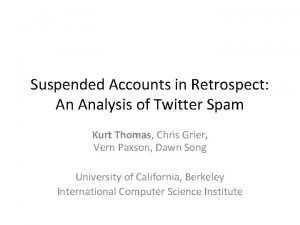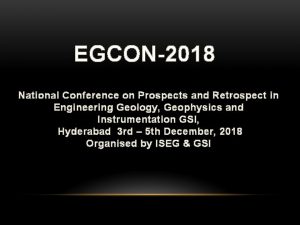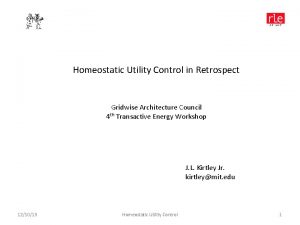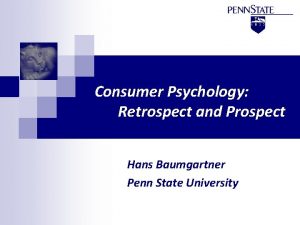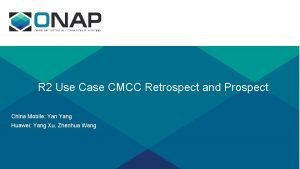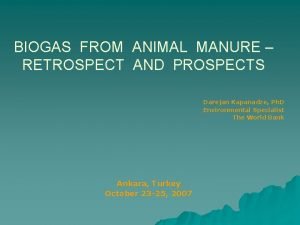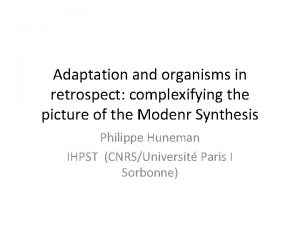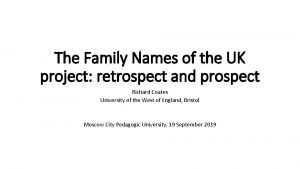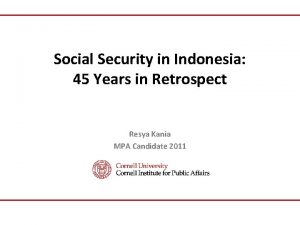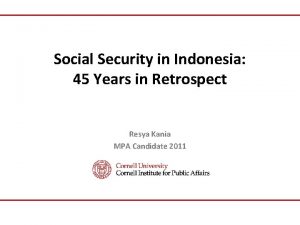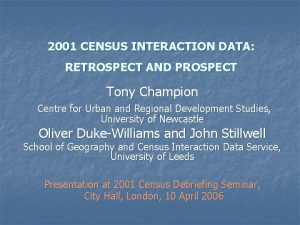Retrospect of GALLEX GNO 1 Retrospect 2 Recent
































- Slides: 32

Retrospect of GALLEX / GNO 1 Retrospect 2 Recent update 3 Why did we stop? Till Kirsten Max-Planck-Institut für Kernphysik Heidelberg / Germany 1

1 RETROSPECT GALLEX / GNO , SAGE Radiochemical Method (product accumulation) Ga 71 + e Ge 71 + e. Low threshold! (0. 233 Me. V) recall: Cl- experiment Till Kirsten, Max-Planck-Institut für Kernphysik Heidelberg, at TAUP 2007, Sendai September 11– 15, 2007 2

Conception of the Gallium Neutrino Experiment GALLEX (later GNO) detection of low energy solar neutrinos Technique: (Ethr = 233 ke. V) 8 12 SNU 7 B 10 % EC, t = 16. 49 days 7% O 71 Ge B 26 e % Tot: 126+9 -7 SNU 72 SNU signal composition: e, e) 9 SNUCN 71 Ga( 33 SNU Basic interaction: pp 57 +pe % p Purpose: Radiochemical Target: 103 tons of Ga. Cl 3 acidic solution containing 30 tons of natural gallium Chemical extraction of 71 Ge every 3 -4 weeks Detection of 71 Ge decay with gas proportional counters Expected signal (SSM): 9 71 Ge counts detected per extraction Till Kirsten, Max-Planck-Institut für Kernphysik Heidelberg, at TAUP 2007, Sendai September 11– 15, 2007 3

Why sub-Me. V Neutrinos? Ø 98 % of all solar neutrinos are sub-Me. V ( 7 ~ 7 % , pp ~ 91 % ). The pp- neutrino flux is coupled to the solar luminosity. It is a fundamental astrophysical parameter that must definitely be measured, as precisely as possible. Stringent limitations (or observation) of departures from the standard solar model can be obtained if the flux of pp neutrinos is deduced, provided that, as it is now possible, neutrino properties are properly folded in. Till Kirsten, Max-Planck-Institut für Kernphysik Heidelberg, at TAUP 2007, Sendai September 11– 15, 2007 4

Ø Below ~1 -2 Me. V, the vacuum oscillation domain takes over from the matter oscillation domain at > 2 Me. V. Also there could be hidden effects only at < 2 Me. V from C. Pena-Garay Till Kirsten, Max-Planck-Institut für Kernphysik Heidelberg, at TAUP 2007, Sendai September 11– 15, 2007 5

Radiochemical experiments Ø cumulative measurement of the integral solar neutrino interaction rate (as opposed to real-time event detection) Ø no spectral or directional information After long time operation of these first generation experiments (Cl, Ga), the statistical errors equal the intrinsic systematic errors. The success of these experiments implies their end. However, they have been crucial in paving the way into the excitement of the third millenium! Till Kirsten, Max-Planck-Institut für Kernphysik Heidelberg, at TAUP 2007, Sendai September 11– 15, 2007 6

GALLEX/GNO Time Table Construction of the detector 1986 - 1990 May 1991 – May 1992 GALLEX I data taking 15 Solar runs, 5 Blanks PL B 285 (1992) 376 PL B 285 (1992) 390 83. 4 ± 19 SNU Jun 1994 – Oct 1994 1 st source experiment PL B 342 (1995) 440 Oct 1995 – Feb 1996 2 nd source 51 Cr experiment PL B 420 (1998) 114 Feb. 1997 51 Cr End of Solar Data Taking PL B 447 (1999) 127 GALLEX Final Result 1594 days – 65 runs: 77. 5 ± 7. 7 SNU Feb 1997 – Apr 1997 Test of the detector with 71 As PL B 436 (1998) 158 Apr 1998 – Apr 2003 GNO data taking PL B 490 (2000) 16 PLB B 616(2005)174 Till Kirsten, Max-Planck-Institut für Kernphysik Heidelberg, at TAUP 2007, Sendai September 11– 15, 2007 7

Granada, June 8 th, 1992 GALLEX announces first observation of solar pp-neutrinos at „Neutrino 92“ Till Kirsten, Max-Planck-Institut für Kernphysik Heidelberg, at TAUP 2007, Sendai September 11– 15, 2007 8

de Rujula Till Kirsten, Max-Planck-Institut für Kernphysik Heidelberg, at TAUP 2007, Sendai September 11– 15, 2007 9

GALLEX RESULT IMPLICATIONS (1992) PL B 285 (1992) 376 60 % of the SSM expectation Definite deficit of 7 Be (or pp-) neutrinos observed 105 % of pp- expectation Hydrogen fusion in the solar interior experimentally observed Till Kirsten, Max-Planck-Institut für Kernphysik Heidelberg, at TAUP 2007, Sendai September 11– 15, 2007 10

Significance of Deficit in Time Till Kirsten, Max-Planck-Institut für Kernphysik Heidelberg, at TAUP 2007, Sendai September 11– 15, 2007 11

GALLEX Final Result 1594 days – 65 runs: 77. 5 ± 7. 7 SNU Till Kirsten, Max-Planck-Institut für Kernphysik Heidelberg, at TAUP 2007, Sendai September 11– 15, 2007 12

Cr source experiments Till Kirsten, Max-Planck-Institut für Kernphysik Heidelberg, at TAUP 2007, Sendai September 11– 15, 2007 13

Till Kirsten, Max-Planck-Institut für Kernphysik Heidelberg, at TAUP 2007, Sendai September 11– 15, 2007 14

Arsenic Tests Repeated tests under variable and purposely unfavorable conditions respective to the Ø standing time Ø mixing- and extraction conditions Ø method and magnitude of carrier addition to exclude witholdings (classical or ‘hot-atom’-effects) Method Triple-batch comparison 30 000 71 As atoms added to: Tank sample External sample Calibration sample ( -spectrom. ) Result: Recovery 99+ % Till Kirsten, Max-Planck-Institut für Kernphysik Heidelberg, at TAUP 2007, Sendai September 11– 15, 2007 15

GALLEX 65 Solar runs = 1594 d 23 Blank runs 77. 5 ± 6. 2 ± 4. 5 SNU 51 Cr GNO 58 Solar runs = 1713 d 12 Blank runs 62. 9 +5. 5 – 5. 3 ± 2. 5 SNU source-, 71 As experiments Till Kirsten, Max-Planck-Institut für Kernphysik Heidelberg, at TAUP 2007, Sendai September 11– 15, 2007 16

FINAL RESULTS GNO GALLEX+GNO 62. 9 ± 6. 0 5. 9 SNU 77. 5 ± 7. 6 7. 8 SNU 69. 3 ± 5. 5 SNU SAGE 66. 9 ± 5. 3 5. 0 SNU Range of SSM predicted rates: No oscillations: 122 – 131 SNU With oscillations 68 – 72 SNU (global fit) Till Kirsten, Max-Planck-Institut für Kernphysik Heidelberg, at TAUP 2007, Sendai September 11– 15, 2007 17

2 RECENT UPDATE Results of a recent complete re-analysis of the Gallex data * (using ~105 Ge-decays per counter) not allowed before completion of the low rate measurment phase (solar runs) - Improved Rn-cut efficiency (multi-year low-rate - Counter efficiency error reduction after full calibration experiment) - full PSA instead of RTA Also for Cr-source data -Counter efficiency error reduction after full calibration (as above) - solar subtraction to include also GNO data * F. Kaether, Ph. D Thesis, Heidelberg University, July 2007 Till Kirsten, Max-Planck-Institut für Kernphysik Heidelberg, at TAUP 2007, Sendai September 11– 15, 2007 18

GALLEX Periods (new vs. old) old (RTA) new (PSA ect. ) Till Kirsten, Max-Planck-Institut für Kernphysik Heidelberg, at TAUP 2007, Sendai September 11– 15, 2007 19

Updated Results GALLEX re-evaluated 77. 5 ± 7. 6 7. 8 SNU 73. 1 ± 7. 1 7. 3 SNU GNO (unchanged) 62. 9 ± 6. 0 5. 9 SNU GALLEX+GNO re-evaluated 69. 3 ± 5. 5 SNU 67. 5 ± 5. 1 SNU Till Kirsten, Max-Planck-Institut für Kernphysik Heidelberg, at TAUP 2007, Sendai September 11– 15, 2007 20

Cr- source update Mean S 1+S 2: 93 ± 8% (1 ) Gallex PL (1998) Re-evaluated: 88 ± 8% (1 ) Thesis Kaether (2007) The expectation value for ground state only is 95 ± 1% Bahcall PR C (1997) Our 71 As-experiment excludes Ge-yield errors >1% Consequences The excited state contribution is probably close to 0, instead of (5 ± 3)% as estimated by Bahcall. Supported also by the SAGE Cr-source result. The 71 Ge production rate prediction on Ga (without oscillatons) must be reduced by ~2 SNU from 7 Be- (32. 7 SNU instead of 34. 8 SNU). [no change for pp- ] Till Kirsten, Max-Planck-Institut für Kernphysik Heidelberg, at TAUP 2007, Sendai September 11– 15, 2007 21

Oscillation parameters If the LMA(MSW) solution is the correct explanation of the SNO/SK data, then vacuum oscillations must dominate below 1 Me. V and the mixing angle is estimated as = 32 1. 6 degrees (B-PG 04) From our data we extract the e-e survival probability Pee for pp-neutrinos after subtraction of the 8 B and 7 Be contributions based on the experimentally determined 8 B- (SNO/SK) and 7 Be- (Borexino) neutrino fluxes as Pee(pp only) = 0. 52 ± 0. 12 THE RESULTS IMPLY THE EXPERIMENTAL VERIFICATION OF THE SOLAR MODEL AND OF THE NEUTRINO OSCILLATION MECHANISMNS AT sub-Me. V ENERGIES THAT ARE OTHERWISE INACCESSIBLE Till Kirsten, Max-Planck-Institut für Kernphysik Heidelberg, at TAUP 2007, Sendai September 11– 15, 2007 22

Partitioning of the Gallium Cake (Experiments, SSM and LMA) SNU measured 68 ± 5 7 Be 22 ± 7 8 B exp 13 N, 15 O pep pp only 4± 1 4. 5 Pee Experim. GX/GNO 0. 68 ± 0. 20 Borexino 0. 33 ± 0. 08 SK + SNO -3 ~0. 5(assumed) - 1. 5 ±. 5 ~0. 5(assumed) - 36 ± 8 0. 52 ± 0. 12 Gallium +1 Till Kirsten, Max-Planck-Institut für Kernphysik Heidelberg, at TAUP 2007, Sendai September 11– 15, 2007 23

3 WHY DID WE STOP? Reasons that existed to continue GNO as long as real-time pp-neutrino detection was (and still is) a long way to go • Continous pp-neutrino monitoring is an astrophysical necessity • pp-observations simultaneously with Borexino real-time beryllium neutrino observations • Further neutrino source experiments to improve the knowledge of relevant cross sections Till Kirsten, Max-Planck-Institut für Kernphysik Heidelberg, at TAUP 2007, Sendai September 11– 15, 2007 24

Reflections on the causes for the termination of the experiment Quote: „The Gallium Neutrino Observatory (GNO) is the price that Italy‘s underground lab is paying to get back on its feet after a small chemical spill nearly two years ago“ (Toni Feder, Physics Today, May 2004) No confusion: The spill occured in Hall C (Borexino) GALLEX/GNO (in Hall A) never spilled a single drop of liquid. Ironically, GALLEX introduced the double spill tray safety conception in 1986, almost 20 years before it now became mandatory for the Laboratory The GALLEX corpse feeded Borexino for survival (the laws of nature) Till Kirsten, Max-Planck-Institut für Kernphysik Heidelberg, at TAUP 2007, Sendai September 11– 15, 2007 25

The End (Gallium was sold in April 2007 to Recapture Metals Inc. , Ontario, Canada) April 6, 2005 : GNO 17, the last regular (semi-annual) GNO meeting was held in Assergi Febr 28, 2006: Final Celebration Ceremony for GALLEX/GNO at Gran Sasso, ending a successful fifteen year period that started with the Inauguration Ceremony on November 30, 1990 Till Kirsten, Max-Planck-Institut für Kernphysik Heidelberg, at TAUP 2007, Sendai September 11– 15, 2007 26

GALLEXInauguration at GRAN SASSO 30. 11. 1990 The Future In n… years: Determine pp-neutrino flux directly with low threshold real-time experiments (Xe, Borexino, …? ) n = 3, 4, 5, 6…? Till Kirsten, Max-Planck-Institut für Kernphysik Heidelberg, at TAUP 2007, Sendai September 11– 15, 2007 27

In memoriam Till Kirsten, Max-Planck-Institut für Kernphysik Heidelberg, at TAUP 2007, Sendai September 11– 15, 2007 28

Luciano Paoluzi † 2002 Till Kirsten, Max-Planck-Institut für Kernphysik Heidelberg, at TAUP 2007, Sendai September 11– 15, 2007 29

Michael Altmann † 31 July 2006 Till Kirsten, Max-Planck-Institut für Kernphysik Heidelberg, at TAUP 2007, Sendai September 11– 15, 2007 30

Nicola Ferrari † 31 July 2006 Till Kirsten, Max-Planck-Institut für Kernphysik Heidelberg, at TAUP 2007, Sendai September 11– 15, 2007 31

Keith Rowley † 29 October 2006 Till Kirsten, Max-Planck-Institut für Kernphysik Heidelberg, at TAUP 2007, Sendai September 11– 15, 2007 32
 Moses and the burning bush keith haring
Moses and the burning bush keith haring Https://drive.google.com/drive/
Https://drive.google.com/drive/ A friend emails you the results of a recent high school
A friend emails you the results of a recent high school Explain recent trends in india's foreign trade
Explain recent trends in india's foreign trade Myips.clever
Myips.clever Recent developments in ict
Recent developments in ict Udin login
Udin login Recent advances in ceramics
Recent advances in ceramics Conclusion of skimming and scanning
Conclusion of skimming and scanning Biotaphonomy
Biotaphonomy Recent developments in object detection
Recent developments in object detection Emerging trends in mis
Emerging trends in mis Sports news in passive voice
Sports news in passive voice Modern trends in project management
Modern trends in project management After kato's serious motorcycle accident
After kato's serious motorcycle accident Many recent college graduates have faced
Many recent college graduates have faced Mpgu
Mpgu Recent demographic changes in the uk
Recent demographic changes in the uk Recent trends in ic engine
Recent trends in ic engine





















